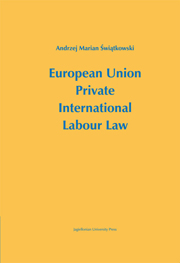Book contents
- Frontmatter
- Contents
- Introductory Comments
- Part I Preliminary Part
- Part II Conflicts of law of individual labour law in the light of the Rome Convention of June 19, 1980 and Regulation of the European Parliament and the Council of the European Communities No. 593/2008 of June 17, 2008 on the law applicable to contractual obligations (“Rome I”)
- Part III Conflict of law issues in individual labour law in light of the Regulation (EC) No. 864/2007 of the European Parliament and the Council of the EU (July 11, 2007), concerning law applicable to Non-Contractual Obligations (“Rome II”)
- Part IV Conflicts of law in collective labour law
- Introduction
- Chapter 1
- Chapter 2 Regulation (EC) No. 864/2007 of the European Parliament and the Council of July 11, 2007 concerning the law applicable to non-contractual obligations (“Rome II”) resulting from collective actions
- Part V Conflicts of law in social security – the coordination of national social security systems of EU Member States according to the regulation of the European Parliament and Council Regulation (EC) No. 883/2004 of April 29, 2004 on the coordination of social security systems
- Part VI International procedural labour law of the European Union
- Selected bibliography
Introduction
from Part IV - Conflicts of law in collective labour law
Published online by Cambridge University Press: 05 September 2014
- Frontmatter
- Contents
- Introductory Comments
- Part I Preliminary Part
- Part II Conflicts of law of individual labour law in the light of the Rome Convention of June 19, 1980 and Regulation of the European Parliament and the Council of the European Communities No. 593/2008 of June 17, 2008 on the law applicable to contractual obligations (“Rome I”)
- Part III Conflict of law issues in individual labour law in light of the Regulation (EC) No. 864/2007 of the European Parliament and the Council of the EU (July 11, 2007), concerning law applicable to Non-Contractual Obligations (“Rome II”)
- Part IV Conflicts of law in collective labour law
- Introduction
- Chapter 1
- Chapter 2 Regulation (EC) No. 864/2007 of the European Parliament and the Council of July 11, 2007 concerning the law applicable to non-contractual obligations (“Rome II”) resulting from collective actions
- Part V Conflicts of law in social security – the coordination of national social security systems of EU Member States according to the regulation of the European Parliament and Council Regulation (EC) No. 883/2004 of April 29, 2004 on the coordination of social security systems
- Part VI International procedural labour law of the European Union
- Selected bibliography
Summary
Introduction
Conflicts of law for collective rights have not been developed in the literature of private international labour law. In the Polish literature, the authors of private international law dealing with the conflict rules of labour law focused exclusively on individual labour law provisions. They did not take up the problems of collective labour law. The same applied in the literature abroad. The International Encyclopedia of Private International Law devotes to the conflict area of collective labour law no more than a dozen lines of text. Gamillscheg, in his literature in the field of the internal system of private international labour law work, 36 years ago came to the conclusion that it is premature to address the issues of collective rights in the context of a conflict of collective labour law governed by national rules of private international law. He separated three levels where conflict rules can apply to substantive labour law relating to industrial relations. These include, collective bargaining agreements, employee representation and collective disputes. These categories are considered by the author as appropriate for use in collective labour relations with a foreign element in collective labour during the time and place of certain undertakings regulated by such law. According to Gamillscheg's views, collective agreements, regardless of their use, are subjected to regulatory provisions in force in the country in which these agreements were negotiated and concluded.
- Type
- Chapter
- Information
- European Union Private International Labour Law , pp. 173 - 174Publisher: Jagiellonian University PressPrint publication year: 2012



